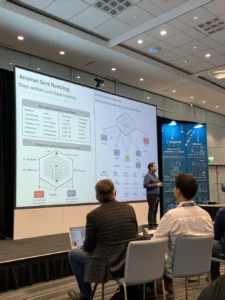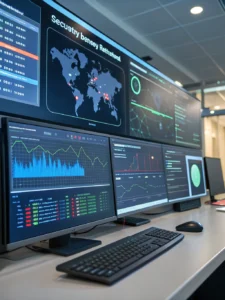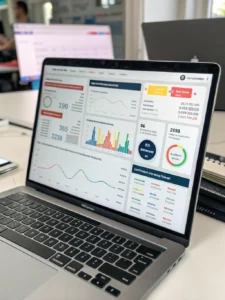AI to the Rescue: How Artificial Intelligence is Armoring Businesses Against Cyber Threats
The AI-Powered Shield: Navigating Cybersecurity Threats in a Rapidly Evolving World The digital landscape is transforming at lightning speed. From the volatile crypto markets to the burgeoning world of AI agents and the ever-present need for smart investment strategies, innovation is constant. But this rapid evolution brings a darker side – a surge in sophisticated cybersecurity threats artificial intelligence solutions are desperately needed to combat. As artificial intelligence (AI) advances, so do the techniques used by cybercriminals. Organizations of all sizes are facing unprecedented risks, demanding a proactive and intelligent approach to security. This post dives deep into the interplay between AI and cybersecurity, exploring the latest threats, the cutting-edge AI solutions available, and how they're reshaping the future of digital defense. The Evolving Threat Landscape: AI as a Weapon in the Hands of Cybercriminals It's no longer enough to rely on traditional security measures like firewalls and antivirus software. Cybercriminals are leveraging AI to automate attacks, evade detection, and amplify their impact. Here's a glimpse into the evolving threat landscape: AI-Powered Malware: Malware is becoming increasingly sophisticated, adapting its code to bypass signature-based detection. AI is used to generate polymorphic malware, constantly changing its appearance to evade security systems. Phishing Attacks on Steroids: AI allows for highly personalized and targeted phishing campaigns, making them much more convincing. These attacks can analyze an individual's online behavior to craft tailored messages that are more likely to succeed. Automated Vulnerability Scanning: Attackers use AI to quickly scan networks for vulnerabilities, identifying weaknesses that can be exploited. Deepfake Manipulation: Deepfakes, AI-generated fake videos and audio, are being used for social engineering attacks, impersonating trusted individuals to gain access to sensitive information. Ransomware as a Service (RaaS): AI enhances RaaS platforms, enabling attackers to automate the entire ransomware process, from identifying targets to encrypting data and demanding ransom. These aren’t hypothetical scenarios; they’re happening now. The scale and complexity of these attacks demand innovative defenses. AI Cybersecurity Tools: The Frontline of Defense Fortunately, the fight against these threats is being met with equally advanced defenses. AI cybersecurity tools are emerging as crucial components of a robust security strategy. These tools utilize machine learning algorithms to proactively detect and respond to threats, automate security tasks, and enhance overall security posture. Here are some key examples: Threat Detection and Prevention: AI-powered systems can analyze network traffic in real-time to identify malicious patterns and anomalies. This goes beyond signature-based detection to identify novel threats that haven't been seen before. Many organizations are now opting for cloud-based security platforms that leverage machine learning to proactively identify and respond to threats before they cause damage. Learn more about cloud security. Security Information and Event Management (SIEM): AI enhances SIEM systems by automating log analysis, prioritizing alerts, and identifying potential security incidents. This reduces the burden on security analysts and enables faster response times. Vulnerability Management: AI helps prioritize vulnerability remediation efforts by analyzing the severity of vulnerabilities and the likelihood of exploitation. This allows organizations to focus on the most critical risks. Endpoint Detection and Response (EDR): AI-powered EDR solutions monitor endpoints for malicious activity, providing real-time threat detection and response. They can automatically isolate infected devices and prevent the spread of malware. Behavioral Analytics: AI establishes baseline behavior for users and systems, alerting security teams to deviations that could indicate a compromise. The effectiveness of ai cybersecurity tools lies in their ability to learn and adapt to evolving threats, providing a dynamic and proactive defense. Beyond Traditional Security: Alternative Strategies for a More Resilient Future While AI-powered defenses are paramount, a holistic cybersecurity strategy demands a multi-layered approach. Here are some alternative and complementary strategies that are gaining traction: Zero Trust Architecture: This security model operates on the principle of "never trust, always verify." It requires strict identity verification for every user and device attempting to access network resources. Explore Zero Trust. Security Awareness Training: Human error remains a top cause of security breaches. Regularly educating employees about phishing scams, social engineering tactics, and safe online practices is essential. Data Encryption: Protecting sensitive data through encryption adds another layer of security, even if a breach occurs. Regular Security Audits and Penetration Testing: Proactively testing your security posture helps identify vulnerabilities before attackers can exploit them. Supply Chain Security: Addressing security risks within the software supply chain is increasingly important, as many organizations rely on third-party vendors. Read about supply chain security risks. Strategy Description Benefits Zero Trust Architecture Verifying every user and device Reduced attack surface, enhanced data protection Minimizes internal threats, improves compliance. Security Awareness Training Educating employees on security threats Reduces human error, improves overall security posture. Cost-effective, builds a security-conscious culture. Data Encryption Protecting data through encryption Safeguards sensitive information, even in case of a breach Ensures confidentiality and integrity of data. Regular Security Audits & Penetration Testing Proactive testing of security posture Identifies and addresses vulnerabilities Helps prevent breaches and ensures compliance. Supply Chain Security Securing third-party vendors Reduces risks associated with vendor vulnerabilities Strengthened overall cybersecurity posture. The Future is Intelligent: Embracing AI for a Secure Tomorrow The clash between cybercriminals and cybersecurity professionals is an ongoing arms race. Cybersecurity threats artificial intelligence solutions are not just a trend; they are becoming a necessity. As AI continues to evolve, so too must our defenses. By embracing intelligent security solutions, adopting proactive strategies, and staying informed about the latest threats, we can build a more resilient and secure digital future. The use of ai cybersecurity tools will only become more widespread and sophisticated. What are your thoughts? Share your experiences with AI and cybersecurity in the comments below! Don’t forget to share this article with your network to help spread awareness about these important issues. You can also subscribe to our newsletter for more insights on tech trends.
Share this content:














Post Comment